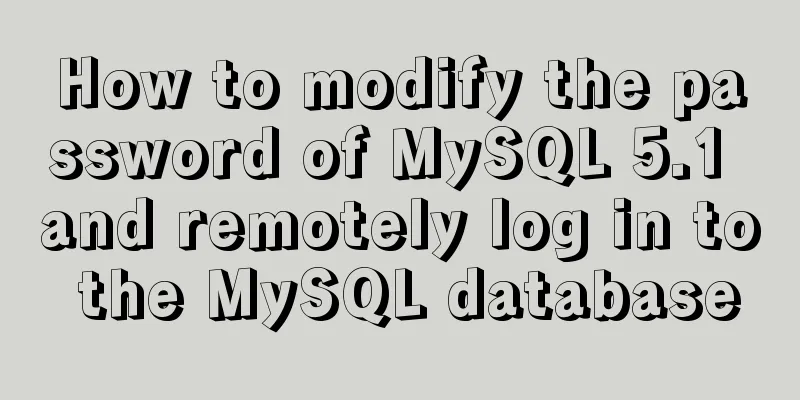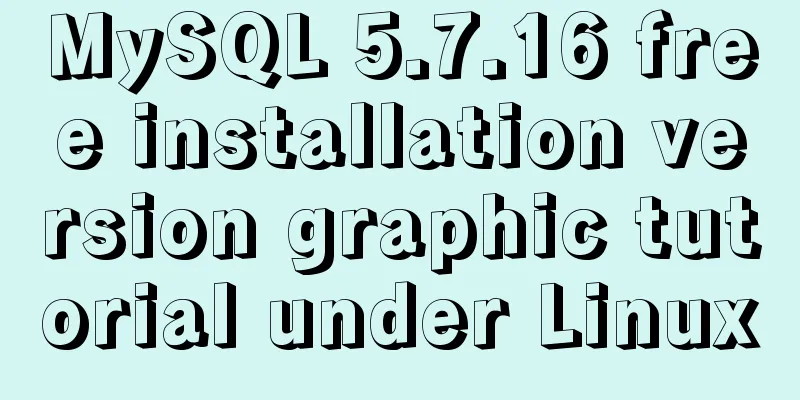Manually install mysql5.7.10 on Ubuntu

|
This tutorial shares the process of manually installing MySQL 5.7.10 on Ubuntu for your reference. The specific contents are as follows 1. Download the installation package MySQL official website download address Select the system version Ubuntu14.04 with the suffix deb_bundle.tar to download Ubuntu Linux 14.04 (x86, 64-bit), DEB Bundle MySQL Server 5.7.x 237.6M (x here means the latest version of MySQL) This article uses mysql5.7.10 as an example (File name: mysql-server_5.7.10-1ubuntu14.04_amd64.deb-bundle.tar) 2. Decompression Unzip it in /usr/local/src: 1) Use the mv command to move the installation package to the target path: mv /home/"currently logged in user name"/"download path of the installation package"/mysql-server_5.7.10-1ubuntu14.04_amd64.deb-bundle.tar /usr/local/src (please modify the path in quotation marks) 2) cd to the target path: cd /usr/local/src 3) Grant permissions: sudo chmod +x mysql-server_5.7.10-1ubuntu14.04_amd64.deb-bundle.tar 4) Decompression: tar -xf mysql-server_5.7.10-1ubuntu14.04_amd64.deb-bundle.tar The following files are extracted: libmysqlclient20_5.7.10-1ubuntu14.04_amd64.deb libmysqlclient-dev_5.7.10-1ubuntu14.04_amd64.deb libmysqld-dev_5.7.10-1ubuntu14.04_amd64.deb mysql-client_5.7.10-1ubuntu14.04_amd64.deb mysql-common_5.7.10-1ubuntu14.04_amd64.deb mysql-community-client_5.7.10-1ubuntu14.04_amd64.deb mysql-community-server_5.7.10-1ubuntu14.04_amd64.deb mysql-community-source_5.7.10-1ubuntu14.04_amd64.deb mysql-community-test_5.7.10-1ubuntu14.04_amd64.deb mysql-server_5.7.10-1ubuntu14.04_amd64.deb mysql-testsuite_5.7.10-1ubuntu14.04_amd64.deb mysql-community_5.7.10-1ubuntu14.04_amd64.changes (You can check it with ls)
3. Terminal command installation 0) Preparation: Update dependency sources and install libaio1 dependencies sudo apt-get update sudo apt-get upgrade apt-get install libaio1 1) The following is my installation order, which is roughly the same for every machine. If the terminal prompts which dependency is missing, you can slightly modify the installation order. sudo dpkg -i mysql-common_5.7.10-1ubuntu14.04_amd64.deb sudo dpkg-preconfigure mysql-community-server_5.7.10-1ubuntu14.04_amd64.deb This step requires you to enter the root password of the data sudo dpkg -i libmysqlclient20_5.7.10-1ubuntu14.04_amd64.deb sudo dpkg -i libmysqlclient-dev_5.7.10-1ubuntu14.04_amd64.deb sudo dpkg -i libmysqld-dev_5.7.10-1ubuntu14.04_amd64.deb sudo dpkg -i mysql-community-client_5.7.10-1ubuntu14.04_amd64.deb sudo dpkg -i mysql-client_5.7.10-1ubuntu14.04_amd64.deb sudo dpkg -i mysql-common_5.7.10-1ubuntu14.04_amd64.deb 2) Install dependency packages sudo apt-get -f install sudo apt-get -f install libmecab2 3) Install mysql-server sudo dpkg -i mysql-community-server_5.7.9-1ubuntu14.04_amd64.deb sudo dpkg -i mysql-server_5.7.9-1ubuntu14.04_amd64.deb 4. Detection, installation and configuration mysql -u root -p Enter the account password you set previously The above is the full content of this article. I hope it will be helpful for everyone’s study. I also hope that everyone will support 123WORDPRESS.COM. You may also be interested in:
|
<<: JavaScript to switch multiple pictures
>>: Autotrash tool for Linux to automatically delete old junk files at a scheduled time
Recommend
Detailed explanation of using Docker to build externally accessible MySQL
Install MySQL 8.0 docker run -p 63306:3306 -e MYS...
Example code for implementing WeChat account splitting with Nodejs
The company's business scenario requires the ...
A brief introduction to mysql mycat middleware
1. What is mycat A completely open source large d...
Basic Implementation of AOP Programming in JavaScript
Introduction to AOP The main function of AOP (Asp...
MySQL SQL Optimization Tutorial: IN and RANGE Queries
First, let's talk about the in() query. It is...
Key knowledge summary of Vue development guide
Table of contents Overview 0. JavaScript and Web ...
How to implement Nginx reverse proxy for multiple servers
Nginx reverse proxy multiple servers, which means...
js to realize web music player
This article shares simple HTML and music player ...
Detailed explanation of MySQL Truncate usage
Table of contents MySQL Truncate usage 1. Truncat...
Detailed explanation of Linux netfilter/iptables knowledge points
Netfilter Netfilter is a packet processing module...
js+canvas realizes code rain effect
This article shares the specific code of js+canva...
Detailed explanation of using JavaScript WeakMap
A WeakMap object is a collection of key/value pai...
js realizes shopping cart addition and subtraction and price calculation functions
This article shares the specific code of js to re...
Code analysis of synchronous and asynchronous setState issues in React
React originated as an internal project at Facebo...
How to draw the timeline with vue+canvas
This article example shares the specific code of ...










